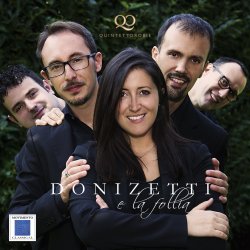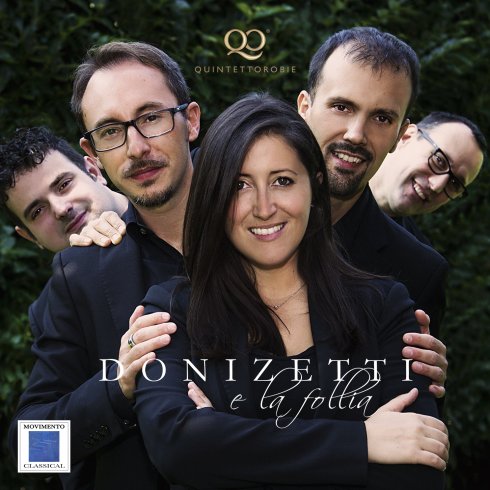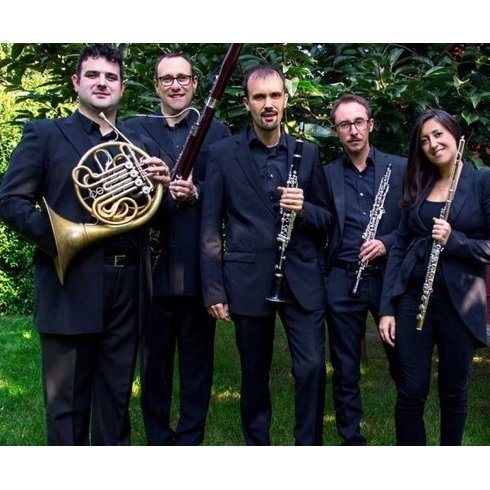

Donizetti e la follia
Together with Rossini, Gaetano Donizetti has been author of great comic melodramas, tragic, serious and semiseri. Studious and impassioned, they share the opinion that his/her tragic masterpiece both “Lucia di Lammermoor”. “Lucia di Lammermoor” finds his/her vertex, his/her perfect synthesis in the very famous one “scene of the folly.” The folly in music is one of the “musical places”, of the topois, of the nineteenth century romanticism, together with the preferences for the night time ambientazionis, for the dark and fantas tic medioevo, among Gothic and cemetery suggestions. The “folly” of “Lucia di Lammermoor” represents the topos in which the bergamasco teacher didn’t have ri vals: not Bellini, not Rossini and not even Verdi to be to the greatest colleagues. The idea from which this proposal was born - now poured into cd after various and positive “narrative concert” stages - was to search and select some of Gaetano Donizetti’s “follies in music”. An idea based on two main reasons. The first is the much richer pres ence of “crazy” characters within the over seventy works of the genius bergamasco: those choices are, for a sort of conditional ante litteram, equally divided between male and female figures ... just enough to re fute the commonplace that “madness is a woman”. And in Donizetti’s catalog there are not many projects that have been initiated and never completed, such as “Una Follia”, or “la Follia di Carnevale” (1818), or the idea conceived by letter, never made of “Jean la folle” (For Opéra, 1844).The other reason is more closely related to Donizetti’s life. “Lucia of Lammermoor” is the drama of insanity, it is well known that Gaetano’s last three years of life, between 1845 and 1848, were marked by chronic para lyzed paralysis, aggravated by a tragic and irreversible loss of consciousness despite the efforts of Baroness Rosa Basoni Scotti and those who were close to him lovingly. The operteur was hit by cerebropathy, badly aggravated during the troubled trip from Ivry health center, Paris (where he had been imprisoned), to his hometown of Bergamo, a feverish and unrequited life. It was a sign of familiarity with the “delusion”, the name of madness at the time? Was it a “predestination” or an aesthetics intimately connected with madness (or even predilection)? In support of this thesis, it seems to be the first step of Gaetano’s opera. “Pigmalione” the lyrical scene in one act, 1816, Donizetti staged the story of the king of Crete, so invaded by the beautiful Galatea statue just completed with his own hands, to ask the gods to live. The request, miraculously fulfilled, causes the protago nist to access madness, a lonely sensation. “Smanio, deliro, deliro e fremo” intonates Pigmalione-Donizetti with the words of Simone Sografi. Adelia (Rome, Apollo Theater, September 11, 1841) is a kind of Lucia’s “cousin”, a story opposite the unfortu nate Ashton’s daughter. Adelia is “the bearer’s daugh ter”. She too, like Lucia, lives a love for Oliviero Count of Wales Fienna, noble of Wales, who knows only who anonymous young man with the red coat, intruded into his secret room. Marriage between the two can not be done, because medieval laws prevented the union be tween plebeians and nobles. Duke Carlo, however, formally grants the exception, with the intention of execut ing Oliviero just to celebrate the wedding. Warned with a message of Carlo’s true intentions, Adelia desperately desperate and does everything to dispel the celebra tion. His father does not understand, comes to threaten her with death and drag her to life on the altar. Adelia, out of her mind, delirious and disgusted, gives voice to all her obsessions, like the dark guy hanging on Olivi ero’s head. The arrival of his beloved, who announces the degree of nobility finally granted by the Duke to the protagonist’s family, makes Adelia laugh and happily dissolves the drama. The opening symphony reflects the medieval colors, between windy sounds, heraldic rhythms and suddenly dramatic backdrops. “I Pazzi per Progetto” (Teatro del Fondo, February 7, 1830) we are in a world of fake madness, as the ti tle suggests, but not new to the era. It is a Neapolitan flourish in which husband and wife, Norina and Colo nel Blinval, find themselves in an asylum and they both pretend to be mentally ill (a subject resumed by Scribe) to test loyalty to each other. The long military life of him has, in fact, been kept away for a long time. From the crackling pages of the pièce, Norina’s wife’s air was extracted, which answers the rhymes to her husband’s “madness”. The story closes, of course, with the recon ciliation between the two. In this case the “madness” gives birth to lazy and intriguing characters of the farce, with flashy and spontaneous flaws. A scene of proverbial madness, one of the best-known ones is “Anna Bolena” (Carcano Theater, December 26, 1830, Milan). The Scene and Final Air “Piangete voi? Donde tal pianto” is the touching and horrified tale of a woman who loves and loves her sincerely, receiving in return trickery, contempt, and finally con demnation to death, which she accepts with no slip and compromise. Anna’s “delusion” is a refuge in the memory of retaking the enchantment of youthful love for Percy, never consumed, the only comfort in the paradox of his desperate real situation. The most famous madness is that of Lucia of Lammer moor (Teatro San Carlo, Naples, 26 September 1835), so well-known that any illustration is superfluous. I em phasize two elements of the masterful musical achieve ment: the “split” of the young bride - the new spouse Arturo spurns to death in the bedroom, then sings by delusing her encounter with the man she wished to marry, Edgardo - is painted by Donizetti With plenty of belcantistic ornaments, abstract portraits of a song that does not find “words to say”, then doubled in imitation by the flute (the glassarmonics in the original score is even more ethereal) creating a splitting effect also be tween gorgheggianti volute and the instrument In eco. Another touching genius, happy ending, is that, well known, of Linda of Chamounix (Vienna, Kartner tortheater, May 19, 1842). The young Swiss girl of the title, in the story of Luigi Rossi (from “La grace de Dieu” by Adolphe-Philippe d’Ennery and Gustave Lemoine) loses herself after two shocking episodes. First the father cursing her, believing her “dishon ored”, no longer virgin; Immediately afterwards, the unfounded news that his beloved Charles, Viscount of Sirval, is about to join in marriage with a noble maid en, renouncing her. The final breakthrough comes with the reunion of the two young men, who had already en shrined their union with the famous cavatina “Oh luce di quest’anima”, brilliant contagion of happiness, in cluded here. The other three works here are those of so many “cra zy” male protagonists. ‘‘L’Esule di Roma” (Naples, San Carlo Theater, January 1, 1828) presents a vibrant scene of Senator Murena’s delusion, entrusted to the bass Luigi Lablache. The title of great success, one of the luckiest of the first Neapolitan period of the author, tells Murena’s unbridled political ambition, which in spite of her career, has condemned the faithful tribe Tribune Stifus, who is also Boyfriend of Argelia, daugh ter of the same Roman senator. A series of incredible situations - including the lions who give up to smack Septimius into the pit of death sentences - crumble Murena’s plots. He, who is now lost, is overwhelmed with remorse and fears, expelled in an intense, shocked maddening air. The recording here proposed “Tacqui allor...l’abbandonai” portrays the moment when Setti mio comes to Rome from exile in the Caucasus - while risking death, and trembling re-meets his city to find Argelia, to tell her at least of her innocence.The forerunner of the last two works was, at the time, the formidable baritone Giorgio Ronconi, one of the pioneers of the vocal type then consecrated by Verdi with Rigoletto. “Il Furioso all’Isola di Santo Domin go” (Rome, Teatro Valle, January 2, 1833) Cardenio, the protagonist, is a blinded man, to the loss of sence, by the betrayal of his wife. “Raggio d’amor parea”, the air recorded here, is a magnificent page where I remember, pain and lyrical carving give musical robe to the incisive verses of Jacopo Ferretti, librettist and friend of Donizetti:
“Raggio d’amor parea/
nel primo april degli anni/
ma quanto bella ell’era/
maestra era d’inganni.
Sul volto avea le rose/
le spine ascose in cor”
The words explain well the divided soul and the unre solved, disenchanted affection of the protagonist. Another superb psychological hub is “Torquato Tasso” (Rome, Valle Theater, September 9, 1833) role as well tailored for Ronconi. Here Donizetti realizes one of the most striking psychological portraits of male madness. Torquato Tasso appears in all his desolate solitude in the third and last act of the work. It is the voice of a poet who, after seven years of segregation, imprisoned by his Duke to avoid a death sentence, finds that the woman he loved, Duchess Eleonora d’Este - “impos sible love” by class difference - Has died for five years. The voice of the horn is entrusted with the lament and expression of all the impotent desolation of the painful return to reality.


Quintetto fiati " Orobie"
From the idea of five musicians from Bergamo in 2016 was born the " Quintetto di Fiati Orobie " with the idea of achieving and proposing a high musical quality. The quintet after having received considerable critical and public success and having established itself in the musical reality of Bergamo, has participated in international festivals such as " I Pomeriggi Musicali di Salò ", " Tignale in Musica " and performances in important musical centers such as Lausanne, Lugano, Milan and Brescia .
At an international level it has achieved various awards such as the 3rd Prize at the VII International Competition "Città di Chieri" (2007 Edition) , the 1st Prize at the XXth European Music Competition of Moncalieri (Edition 2008) and the 2nd Prize at the IX International Competition “Città di Chieri” (first not awarded, 2010 Edition).
In 2008 the quintet participated in the International Competition of Chamber Music in Lyon (Edition 2008), a competition considered unanimously among the most prestigious in the world.
The repertoire of the " Quintetto di Fiati Orobie " includes original pieces of this formation, famous transcriptions of opera arias, overtures and fairy tales in music (like “Peter and the Wolf”). In the summer of 2011 the quintet has become promoter of the Italian panorama of wind quintets creating the Masterclass of the “Quintetto Bibiena”. In 2016 the quintet has started the project “Donizetti e la Follia", in collaboration with the music critic Bernardino Zappa and with the patronage of the Donizetti Foundation. The group consists of Valentina Noris (Flute); Davide Bresciani (Oboe); Santo Manenti (Clarinet); Alessandro Valoti (Horn); Oscar Locatelli (Bassoon).
